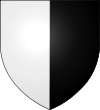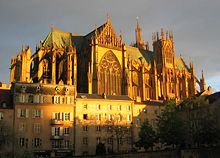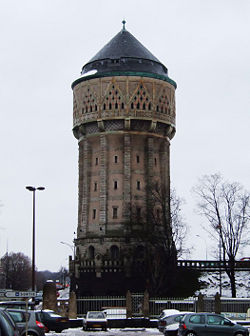Metz
| Ville de Metz | ||
|
 |
|
| City flag | City coat of arms | |
|
Motto: Si paix dedans, paix dehors |
||
 |
||
| Cathedral St. Etienne in Metz | ||
| Location | ||
|
||
| Time Zone | CET (GMT +1) | |
| Administration | ||
|---|---|---|
| Country | France | |
| Region | Lorraine | |
| Department | Moselle | |
| Arrondissement | Metz-Ville | |
| Intercommunality | Metz Métropole | |
| Mayor | Dominique Gros (PS) (2008-2014) |
|
| City Statistics | ||
| Land area¹ | 41.9 km² | |
| Population² (2005) |
124,500 | |
| - Ranking | 28th in France | |
| - Density | 2951/km² (1999) | |
| Urban Spread | ||
| Urban Area | 363 km² (1999) | |
| - Population | 322,526 (1999) | |
| Metro Area | 1,837 km² (1999) | |
| - Population | 429,588 (1999) | |
| Miscellaneous | ||
| INSEE/Postal code | 57463/ 57000 | |
| 1 French Land Register data, which excludes lakes, ponds, glaciers > 1 km² (0.386 sq mi or 247 acres) and river estuaries. | ||
| 2 Population sans doubles comptes: residents of multiple communes (e.g., students and military personnel) only counted once. | ||
Metz (pronounced [mɛs] in French) is a city in the northeast of France, capital of the Lorraine region and prefecture of the Moselle department.
It is located at the confluence of the Moselle and the Seille rivers.
Although historically Nancy was the capital of the duchy of Lotharingia, it was Metz which was chosen as the capital of the newly created région of Lorraine in the middle of the 20th century, because of its past history as the capital of the region of Lotharingia - an origin found much more republican-friendly than the duchy-related theory, pointing to Nancy as the region capital.
Contents |
History
Roman Divodurum
In ancient times Metz, then known as Divodurum (the town at the holy mountain), was the capital of the Celtic Mediomatrici, and the name of this tribe, abbreviated to Mettis, formed the origin of the present name. At the beginning of the Christian Era, the site was already occupied by the Romans. Metz became one of the principal towns of Gallia, more populous than Lutetia, rich thanks to its wine exports and having one of the largest amphitheatres of the country. As a well-fortified town at the junction of several military roads, it soon grew to great importance. One of the last Roman strongholds to surrender to the Germanic tribes, it was captured by Attila in 451, and finally passed, about the end of the fifth century, through peaceful negotiations into the hands of the Franks.
Early Frankish Metz
Though the first Christian churches were to be found outside the city, the existence in the fifth century of the oratory of St. Stephen within the city walls has been fully proved. In the beginning of the seventh century the oldest monastic establishments were those of St. Glossinde and St. Peter.
Since King Sigibert I, Metz frequently was the residence of the Merovingian kings of Austrasia and especially the reign of Queen Brunhilda reflected great splendour on the town.
The town preserved the good-will of the rulers, when the Carolingians acceeded to the Frankish throne, as it had long been a base of their family and one of their primal ancestors, Saint Arnulf of Metz, as well as his son Chlodulf, had been bishops of Metz. Charlemagne considered making Metz his chief residence before he finally decided in favour of Aachen.
There is evidence that the earliest Western musical notation, in the form of neumes in camp aperto (without staff-lines), was created at Metz around 800, as a result of Charlemagne's desire for Frankish church musicians to retain the performance nuances used by the Roman singers.[1]
In the basilica, Louis the Pious and his half-brother the Bishop Drogo were buried and Charles the Bald was crowned there.
Lotharingian Metz
In 843 Metz became the capital of the Kingdom of Lotharingia, and several diets and councils were held there. Numerous Christian manuscripts, the product of the Metz schools of writing and painting, such as the famous "Trier Ada" manuscript and the Drogo Sacramentary for the personal use of a bishop of the royal house (Bibliotheque Nationale, Paris), are evidence of the active intellectual lives and sumptuous patronage of Carolingian Metz.
After the death of king Lothar II the kingdom of Lotharingia, and with it Metz, was contested and changed back and forth between the Eastern and the Western Frankish kingdom until in 925 it finally became part of the East kingdom and subsequently the Holy Roman Empire.
The increasing influence of the bishops in the city became greater when Adalbert I (928-62) obtained a share of the privileges of the counts; until the twelfth century, therefore, the history of the town is practically identical with that of the bishops (see [1]). In 1039 a splendid edifice was built to take the place of the old church of St. Stephen.
In the spring of 1096, Metz became one of the scenes of the Rhineland massacres of non-Christians as Count Emicho of Fionheim gathered followers for the First Crusade. A group of these crusaders entered Metz, forcibly converting Jewish families, and killing those who resisted baptism. 22 Jewish citizens of Metz were slaughtered.
The commune of Metz
In the twelfth century, the burgesses began efforts to free themselves from the domination of the bishops. In 1180, the burgesses formed a close corporation, the Tredecem jurati, which were appointed as municipal representatives in 1207. The burgesses were still nominated directly by the bishop, who had also a controlling influence in the selection of the presiding officer of the board of aldermen (which originated in the eleventh century). The twenty-five representatives sent by the various parishes held an independent position; in judicial matters they helped the Tredecem jurati and formed the democratic element of the system of government. The other municipal authorities were chosen by the town aristocracy, the so-called Paraiges, i. e. the five associations whose members were selected from distinguished families to protect the interests of their relatives. The other body of burgesses, called a Commune, also appears as a Paraige from the year 1297; in the individual offices it was represented by double the number of members that each of the older five Paraiges had. Making common cause, the older family unions and the Commune found it advantageous to gradually increase the powers of the city as opposed to the bishops, and also to keep the control of the municipal government fully in their hands and out of that of the powerful growing guilds, so that until the sixteenth century Metz remained a purely aristocratic organization. In 1300 the Paraiges gained the right to fill the office of head-alderman, during the fourteenth century the right to elect the Tredecem jurati, and in 1383 the right of coining. The guilds, which during the fourteenth century had attained great independence, were completely suppressed (1383), and the last revolutionary attempt of the artisans to seize control of the city government (1405) was put down with much bloodshed.

The city had often to fight for its freedom; from 1324-27 against the Dukes of Luxembourg and Lorraine, as well as against the Archbishop of Trier; in 1363 and 1365 against the band of English mercenaries under Arnold of Cervola, in the fifteenth century against France and the Dukes of Burgundy, who sought to annex Metz to their lands or at least wanted to exercise a protectorate. Nevertheless it maintained its independence, even though at great cost, and remained, outwardly at least, part of the German Empire, whose ruler, however, concerned himself very little with this important frontier stronghold.
French Metz
Charles IV in 1354 and 1356 held brilliant diets here, at the latter of which was promulgated the famous statute known as the "Golden Bull". The town therefore felt that it occupied an almost independent position between France and Germany, and wanted most of all to evade the obligation of imperial taxes and attendance at the diet. The estrangement between it and the German States daily became wider, and finally affairs came to such a pass that in the religious and political troubles of 1552 Metz found itself in the middle of the war between Charles V and the rebellious princes. By an agreement of the German princes, Moritz of Saxony, William of Hesse, John Albrecht of Mecklenburg, and George Frederick of Brandenburg, with Henry II of France, ratified by the French king at Chambord (15 January), Metz was formally transferred to France, the gates of the city were opened (10 April), and Henry took possession as vicarius sacri imperii et urbis protector (18 April). Francis, Duke of Guise, commander of the garrison, restored the old fortifications and added new ones, and successfully resisted the attacks of the emperor from October to December, 1552; Metz remained French.
The recognition by the empire of the surrender of Metz to France came at the conclusion of the Peace of Westphalia. By the construction of the citadel (1555-62) the new government secured itself against the citizens, who were discontented with the turn of events. Important internal changes soon took place. In place of the Paraiges stood the authority of the French king, whose representative was the governor. The head-alderman, now appointed by the governor, was replaced (1640) by a Royalist Mayor. The aldermen were also appointed by the governor and henceforth drawn from the whole body of burgesses; in 1633 the judgeship passed to the Parliament. The powers of the Tredecem jurati were also restricted, in 1634 totally abolished, and replaced by the Bailliage royal.

Among the cities of Lorraine, Metz held a prominent position during the French possession for two reasons: In the first place it became one of the most important fortresses through the work of Vauban (1674) and Cormontaigne (1730); secondly, it became the capital of the temporal province of the three bishoprics of Metz, Toul, and Verdun, which France had seized (1552) and, by the Peace of Westphalia, retained. In 1633 there was created for this "Province des trois évêchés" (also called "Généralité des trois évêchés" or "Intendance de Metz") a supreme court of justice and court of administration, the Metz Parliament. In 1681 the Chambre Royale, the notorious Assembly chamber, whose business it was to decide what fiefs belonged to the three bishoprics which Louis XIV claimed for France, was made a part of this Parliament, which lasted, after a temporary dissolution (1771-75), until the final settlement by the National Assembly in 1789, whereupon the division of the land into departments and districts followed. Metz became the capital of the Department of Moselle, created in 1790. The revolution brought great calamities upon the city. In the campaigns of 1814 and 1815 the allied armies twice besieged the city, but were unable to take it.
1819: A view of Metz after the Bourbon restoration
In July 1819, the Scots born naval officer Norwich Duff visited Metz and recorded a detailed description of the town:
Metz is a large and strongly fortified town, beautifuly situated on a plain at the confluence of the Moselle and Seille. It manufactures woollen goods, linen, china, paper, oil, starch and is famous for its hams, liquers, sweetmeats and artificial flowers: they also have a king's manufactory of gun powder. The Government House and the promenades round it are very fine: there is also [an] immence extent of barracks for troops, a large cathedral and a theatre. From the number of running ditches formed by the river there are a great many bridges: the streets like all French towns [!] are narrow and dirty and the houses high: the ground is also very uneven on which they stand. Some street performers gave us a little very tolerable music during our dinner
Metz and the Franco-Prussian War
During the Franco-Prussian War of 1870-71 Metz was the headquarters and rendezvous of the Third French Army Corps under Bazaine. Through the operations of the German army, Bazaine, after the battles of Colombey, Mars-la-Tour, and Gravelotte (14-18 August) was besieged in Metz. The German army of investment was commanded by Prince Friedrich Karl of Prussia; as the few sorties of the garrison were unable to break the German lines, Metz was forced to surrender (27 October), with the result that 6000 French officers and 170,000 men were taken prisoners. Philosopher Friedrich Nietzsche took part in the siege of Metz as a German soldier.
By the Treaty of Frankfurt of 1871, Metz became a German city, and was made a most important garrison and a strong fortress. The fortifications on the south and east were levelled in 1898, securing space for growth and development. Some large neo-Romanesque buildings typical of the German Empire were constructed in the city.
20th century and modern day Metz
Following the armistice with Germany ending the First World War, the French army entered Metz in November 1918 and the city was returned to France at the Treaty of Versailles in 1919.
Metz was again annexed by Nazi Germany between 1940 and 1944 during the Second World War, and was reverted to France after the war.
Nowadays, the military importance of Metz has decreased, and the city has diversified its economic base. Expansion has continued in the recent decades despite the economic crisis that besets the rest of Lorraine. However, Metz is in the heart of a new economic region known as the SaarLorLux Which combines the culture and economic aspects of this unique region in Europe. The City has developed its University and overall infrastructure for the EU's 2007 "Culture Region" (GER: Kultur Großregion). The Metz Technopôle is also an example of the economic revival of Metz and its region. The Technopôle, a high-tech park spread over 180 hectares, was established in 1983 and has attracted over 200 companies, 4000 employees and 4500 students. World-class academic institutions such as Georgia Tech and Supélec along with established companies including ProConsultant, SFR and TDF are located at the Technopôle.
Sights

The city is famous for its yellow limestone architecture: la Pierre de Jaumont and for its nickname "The Green City" (25m2 - 270sqft of park/garden/playground per inhabitant)
- St. Etienne, Gothic cathedral featuring stained glass windows designed by Marc Chagall)
- St-Pierre-aux-Nonnains, the oldest church in France, built between 380 and 395AD as a Roman gymnasium; converted to a Christian church in the 7th century.
- Ste-Segolene church, (built 13th-14th century)
- St-Martin church
- St-Vincente church
- St-Pierre-de-la-Citadelle church
- St-Euchaire church
- St-Maximin church
- Ruins of city walls
- City gates: Porte Serpenoise, Porte des Allemands (German Gate)
- Opéra-Théâtre de Metz - Theatre and Opera House, built between 1732 and 1752 and the oldest in France
- Jewish Cemetery
- Railway Station (built in 1908) and the imperial area build during German occupation
Transport
Motorway
Metz is ideally located at the intersection of two majors axes: A4 motorway (going from Paris to Strasbourg)Also the A4 is a part of the E50 Motorway connecting Paris, France to Prague, Czech Republic and the A31 motorway (going to Luxembourg at the North and towards Nancy, Dijon and Lyon at the South).
High speed train (TGV)
Metz is connected to the French high speed train (TGV) network, which provides direct train to Paris and Luxembourg cities. The time from Paris (East station) to Metz train station is 82 minutes. Additionally Metz is served by the 'Lorraine TGV' train station, located at Louvigny, 25 km to the south of Metz, for high speed trains going to Nantes, Rennes, Lille or Bordeaux (without stopping in Paris). 'Lorraine TGV' is at 75 mn of train from Paris Airport (Roissy - Charles de Gaulle).
Regional trains
Metz is one of the main stations of the regional express trains systems named Metrolor. One of the main lines is the Nancy-Metz-Luxembourg line, completed by many lines going to main cities of the area.
Local transportation
Local transportation in the agglomeration is carried out by TCRM buses.
Sports and events
- FC Metz, a football team in Ligue 1, the first league in French football
- The Open de Moselle, a tournament of the ATP International Series, is played in Metz.
- Europe's largest hot air balloon festival, hosted by Metz every other year - http://www.pilatre-de-rozier.com/
Apollo-Soyuz Test Project
The town of Metz has the distinction of being the location over which the first international handshake in space occurred. On July 17, 1975 an American Apollo Spacecraft docked with a Soviet Soyuz Spacecraft in the first joint international mission in history. When the two spacecraft docked, the hatch was opened and Commanders Thomas P. Stafford and Aleksei Leonov shook hands which happened to occur over the town of Metz.
Notable people from Metz
Metz was the birthplace of:
- Rabbenu Gershom (960 – 1040?), rabbi
- Charles Ancillon (1659 – 1715), prominent Huguenot
- Adam Philippe de Custine (1740-1793), general
- Pierre-Louis Roederer (1744-1835), politician and economist
- Francois Barbé-Marbois (1745 – 1837), politician in the French Revolutionary government
- Jean-François Pilâtre de Rozier (1754 – 1785), first man to fly in a hot air balloon
- François Étienne de Kellermann (1770-1835), general of Napoléon
- Antoine Charles Louis Lasalle (1775-1809), general of Napoléon
- Ambroise Thomas (1811-1893), composer
- Marie-Eugénie de Jésus (1817 - 1898), founder of the Religious of the Assumption
- Louis Le Prince (1841 – 1890), first man to shoot moving images
- Paul Verlaine (1844 – 1896), poet
- Max Braubach (1899 – 1975), German historian
- S. M. Stirling (1953 – ), science fiction author
Sister cities
Metz is twinned with:
 Trier, Germany, since 1957
Trier, Germany, since 1957 Karmiel, Israel, since 1984
Karmiel, Israel, since 1984 Yichang, China, since 1991
Yichang, China, since 1991 Hradec Králové, Czech Republic, since 2001
Hradec Králové, Czech Republic, since 2001 Kansas City, Missouri, United States, since 2003
Kansas City, Missouri, United States, since 2003 Saint-Denis, Réunion, France
Saint-Denis, Réunion, France Gloucester, United Kingdom
Gloucester, United Kingdom Luxembourg city, Luxembourg
Luxembourg city, Luxembourg
See also
- Fortifications of Metz
- Open de Moselle
- Diocese of Metz
- Jonathan Eybeschutz
Notes
- ↑ James Grier Ademar de Chabannes, Carolingian Musical Practices, and "Nota Romana", Journal of the American Musicological Society, Vol. 56, No. 1 (Spring, 2003), pp. 43-98, retrieved July 2007
External links
- Official Town Council website
- Pictures of Metz
- Historic maps
- Metz.Online.Fr - Your guide to all web sites related to Metz
- Video about the famous Christmas market of Metz
- Metz Technopôle website
This article incorporates text from the entry Metz in the public-domain Catholic Encyclopedia of 1913.
|
|||||||||||
|
|||||

